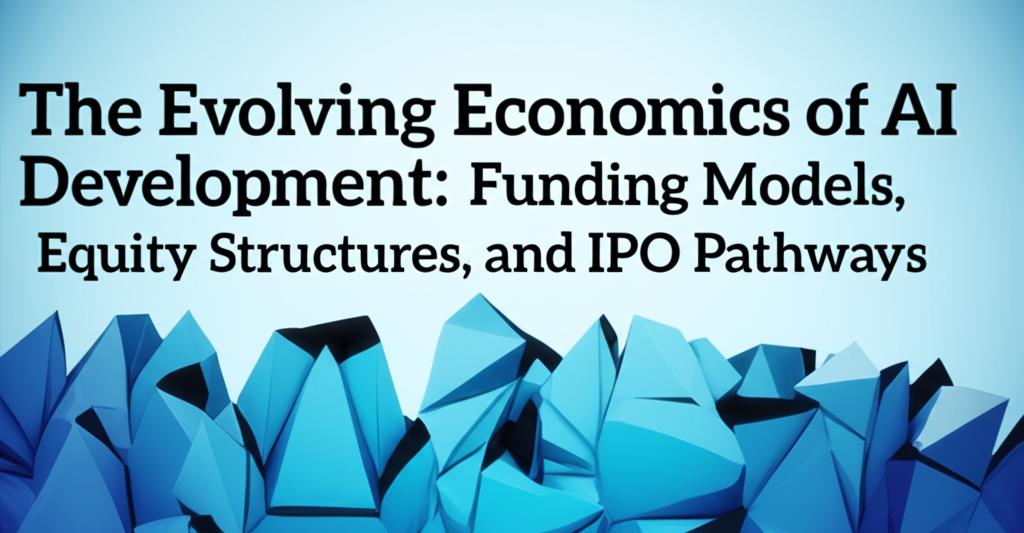The landscape of Artificial Intelligence development is not just a technological frontier; it's a rapidly reshaping economic one. Understanding the evolving financial underpinnings of AI companies, from their initial funding to potential public offerings, is crucial for founders, investors, and a
The landscape of Artificial Intelligence development is not just a technological frontier; it's a rapidly reshaping economic one. Understanding the evolving financial underpinnings of AI companies, from their initial funding to potential public offerings, is crucial for founders, investors, and anyone involved in the AI ecosystem.
Shifting Funding Landscapes: Beyond Traditional VCVenture capital remains a cornerstone of AI funding, yet the nature of these investments is changing. The immense computational power and specialized talent required for cutting-edge AI, particularly foundational models and generative AI, have led to mega-rounds and a concentration of funding in a few well-positioned players. We're seeing a diversification of funding sources:
- Corporate Venture Capital (CVC) and Strategic Partnerships: Large tech companies are not just acquiring AI startups but are also heavily investing and forming strategic partnerships. These deals often go beyond capital, providing access to proprietary data, cloud computing resources, and established distribution channels, which can be more valuable than cash alone.
- Sovereign Wealth Funds and National Initiatives: Recognizing AI's strategic importance, governments and sovereign wealth funds worldwide are injecting substantial capital into national AI champions and research initiatives. This aims to foster domestic AI ecosystems and reduce reliance on foreign technology.
- Rise of Compute-as-Equity: The staggering cost of compute for training large AI models has led to innovative funding structures. Some cloud providers and specialized AI hardware companies are offering compute resources in exchange for equity or future revenue share, aligning interests and providing a lifeline for compute-hungry startups.
- Specialized AI Funds: We are observing the growth of venture funds specializing exclusively in AI. These funds bring deep domain expertise, a better understanding of AI-specific risks and opportunities, and a network tailored to the AI industry.
- Crowdsourcing and Community-Driven Models: While less common for core AI model development due to high capital needs, certain AI application layers and open-source initiatives are exploring community funding and tokenization, particularly in decentralized AI (DeAI) projects.
In the fierce war for AI talent, particularly researchers and engineers capable of building and advancing complex models, equity structures are evolving. Standard employee stock option plans (ESOPs) are still prevalent, but nuances are emerging:
- Aggressive Equity Grants for Key Hires: Companies are offering significant equity stakes, sometimes comparable to co-founder levels, to attract leading AI researchers. This acknowledges the immense value these individuals bring.
- Performance-Based Vesting Tied to Milestones: Beyond time-based vesting, some equity grants are tied to specific technological breakthroughs, model performance improvements, or successful product launches, aligning incentives more directly with innovation.
- Secondary Markets for Private Stock: The longer runway to an IPO for many AI companies has increased the importance of secondary markets, allowing early employees and investors to gain some liquidity before a public offering. Companies are becoming more proactive in facilitating these transactions.
- Tiered Equity for Data and Model Contributions: In collaborative or open-source inspired AI ventures, there's exploration of tiered equity or token rewards for significant contributions of data, pre-trained model components, or specialized algorithms.
The path to an Initial Public Offering (IPO) for AI companies is keenly watched, serving as a barometer for the sector's maturity and investor appetite. While the tech IPO market has seen fluctuations, strong AI narratives continue to attract interest.
- Focus on Sustainable Business Models: Investors are increasingly scrutinizing beyond the AI hype, looking for clear paths to profitability, strong unit economics, and defensible moats. Companies that can demonstrate recurring revenue, customer retention, and efficient customer acquisition are better positioned.
- The "AI-Enabled" vs. "AI-Core" Distinction: The market differentiates between companies using AI to enhance existing products or services ("AI-enabled") and those whose core offering is the AI technology itself ("AI-core"). The latter often face higher R&D costs but can command premium valuations if their technology is groundbreaking.
- Vertical AI Solutions Gaining Traction: While foundational model companies capture headlines, AI companies applying specialized models to specific industry verticals (e.g., healthcare, finance, manufacturing) are demonstrating clearer ROI and market fit, making their IPO narratives compelling.
- Direct Listings and SPACs: Alongside traditional IPOs, direct listings and, to a lesser extent recently, Special Purpose Acquisition Companies (SPACs) have been considered by some AI firms. The choice of pathway depends on market conditions, company maturity, and desired speed to market. However, regulatory scrutiny and market performance have tempered enthusiasm for SPACs.
- Storytelling and Metrics: Successfully navigating an IPO requires AI companies to articulate a clear, compelling story about their technology's transformative potential and its translation into financial performance. Key metrics include not only standard SaaS metrics like ARR (Annual Recurring Revenue) and LTV/CAC (Customer Lifetime Value/Customer Acquisition Cost) but also AI-specific indicators like model accuracy, inference speed, and the scale of proprietary datasets.
The economics of AI development are dynamic and will continue to evolve alongside technological advancements and market maturation. Flexibility, strategic partnerships, a keen focus on talent, and a clear path to sustainable value creation will be key for AI companies navigating this exciting and challenging financial landscape.

